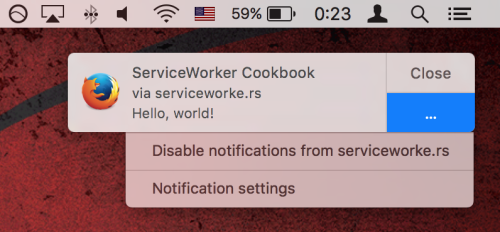maniei.ir
یاد من باشد فردا حتما باور این را بکنم، که دگر فرصت نیست و بدانم که اگر دیر کنم ،مهلتی نیست مرا و بدانم که شبی خواهم رفت و شبی هست، که نیست، پس از آن فرداییmaniei.ir
یاد من باشد فردا حتما باور این را بکنم، که دگر فرصت نیست و بدانم که اگر دیر کنم ،مهلتی نیست مرا و بدانم که شبی خواهم رفت و شبی هست، که نیست، پس از آن فرداییFirefox 44
Firefox 44 hits stable channel with support for push notifications

Firefox 44, the latest release channel build of Mozilla's web browser, is now available for Windows, Mac, Linux and Android. Notably, Firefox 44 lets users receive push notifications from websites so long as permission is granted (opt-in
Mozilla says the push notification feature is similar to web notifications with the exception that you can now receive notifications from websites even when they aren't open. As you can imagine, this could be incredibly useful for things like e-mail, weather, social networking and shopping – you know, sites and services that you'd otherwise manually check for updates. Push notifications can be managed in the Control Center

Developers that want to implement push notifications on their website can learn more by checking out this Hacks blog post
It's worth noting that Mozilla is simply playing catch-up at this point as it relates to push notifications. Google first introduced push notifications in Chrome nearly three years ago with Apple's Safari following suite a few months later
Elsewhere, Firefox 44 enables H.264 video playback (so long as you have a native decoder), improves warning pages for certificate errors and untrusted connections and enables WebM/VP9 video support on systems that don't support MP4/H.264. The full change log can be viewed on Mozilla's website
Firefox 44 can be downloaded by clicking here
Skype
Now you can Skype with people who speak a different language in real-time
Microsoft released Skype Translator in late 2014 as a standalone app for Windows 8. As of today the translation feature is integrated directly into the desktop version of Skype (for users on Windows 7, Windows 8, and Windows 10.) Now you can have a conversation with someone who speaks English, French, German, Italian, Mandarin, or Spanish -- without knowing the language yourself.
On the company blog, Skype said that this update furthers their dream of breaking language barriers and unifying people around the world.
"Researchers, engineers, and many others across Microsoft have been working hard to make this dream a reality and we are looking forward to bringing this preview technology to more devices,” the post said.
Look for an update to the Skype for Windows desktop app in the next few weeks: A new translator button will appear within conversations. Translation is available for audio and video call as well as instant messages (then 50 languages will be supported, not just six.)
dislike
Facebook gives in, will soon add a form of "dislike" button

Facebook is working on a feature that fans of the social networking site have been requesting for years: a “dislike” button. Founder and CEO Mark Zuckerberg made the admission during a recent “town hall” meeting at its Menlo Park headquarters according to multiple reports.
The social networking giant has up to this point been reluctant to add a “dislike” button, and for good reason.
In case you haven’t noticed, the Internet isn’t a very friendly place. Don’t believe me? Visit YouTube or your favorite news site and skim through the comments section. Without fail, the discussion turns ugly almost immediately.
Services like Facebook are one of the few places to turn for kind, encouraging commentary. Sure, Facebook is full of people that dislike their “friends” and get annoyed at times by what they say but generally, it’s a much more positive atmosphere due largely to its intimate nature.
The traditional “like” button simply isn’t suitable for every status update. If your best friend’s mother dies, for example, do you “like” that update? Of course not, as that would imply you’re happy she’s gone. Scenarios such as this are where a “dislike” button would be desirable.
Zuckerberg said his team is close to unveiling the new feature and that it’s been surprisingly complicated to make an interaction that will be simple.
It’ll be interesting to see just how Facebook plans to walk that fine line between empathy and hate.
internet for all
Since its birth in the labs of ARPANET half a century back, Internet has risen to create a truly global communication system connecting people across the world. The last two decades has seen users rising from forty million to around 3 billion, with one billion added in the last four-five years itself. This exponential growth is fueled primarily by three factors: a robust and resilient global network, growth of cheaper and powerful computing driven by the Kurzweil curve and an ecosystem of relevant services created by new companies powered by network effects.
The Elephant in the Room
Over 4 billion people still remain unconnected to the Internet. Users today are predominantly urban since vast majority of investments by telecom industry went into solving the problem of capacity and complexity while not investing enough on last mile access. Case in point, the United States. Over 10 million have no access and 17% of its population (incl. over half of rural Americans) lack quality broadband access. The problem is not merely economic (lower rural revenue, higher capex) as often argued, but also because of technological limitations. In a developing country such as India, this problem is compounded by lack of reliable support infrastructure (like grid power).

US Mobile Broadband Map. Source: 2015 Broadband Progress Report, US FCC
To solve the last mile connectivity problem, we must design a network with the end user in mind. Smartphones today provide the lowest point of entry ($30–35 Android) to the Internet and over a billion of them are being produced annually. To bring the next four billion people on to the Internet in the next few years, wireless (3G/LTE/WiFi) should act as the primary access network.
Firefox
Mozilla releases 64-bit Firefox for Windows with latest Developer Edition

Mozilla has finally released a 64-bit version of their Firefox web browser for Windows, joining other major browsers including Google Chrome, Internet Explorer and Opera in offering 64-bit variants.
However, at this stage the 64-bit version of Firefox is a Developer Edition build, which is one of Mozilla's beta builds of Firefox. While the Developer Edition channel is far more stable than the Nightly channel, it's not the same as the main builds of Firefox that users will typically download. As such, 64-bit Firefox could be considered as being in the beta phase at this stage.
If all goes to plan, Mozilla will release a stable version of 64-bit Firefox for Windows with Firefox 38, scheduled for release in May. At that point it will sit alongside the already-released 64-bit variants for OS X and Linux.
Firefox 38 Developer Edition, complete with 64-bit addressing, brings support for web applications larger than 4 GB, which is great for developers wanting to build large browser-based games. Thanks to new hardware registers and a larger address space, Mozilla claims the 64-bit version is also faster and more secure than before.
The latest Developer Edition also includes some WebRTC changes and fixes, as well as a few other improvements for developers. Anyone interested in upgrading to the 64-bit version of Firefox can do so via Mozilla's Developer Edition page.
Kaspersky
Kaspersky Lab uncovers a suite of surveillance platforms that hide in hard drive firmware

Security researchers at Kaspersky Lab have unearthed a suite of surveillance platforms that can hide within the firmware of hard drives from more than a dozen manufacturers. The attackers, which Kaspersky is calling the Equation Group due to their complex skill set, are the most advanced that the researchers have encountered to date.
The programs, some of which date back to 2001, appear to have been developed in succession with each new program being more sophisticated than the last according to Wired.
Personal computers in more than 30 different countries have been discovered to carry the infection, Kaspersky said.

One of the worms uncovered has direct connections with Stuxnet and may have even been used as a test to help figure out the best route for the malware to reach systems involved in Iran’s nuclear program. Researchers didn’t name who they believe might be behind the attacks although there’s a good bit of circumstantial evidence that points to the NSA.
One component of the suite, GrayFish, is able to reflash the firmware on hard drives. Because it resides in the firmware, reformatting the drive doesn’t get rid of the infection. Key to being able to rewrite the firmware is having access to source code. If the NSA is indeed behind the attacks, getting source code wouldn’t present too much of an issue.
In addition to physically intercepting shipments (in this case, hard drives) and loading them with malware before repackaging and sending to targets, the NSA could have simply asked manufacturers for their source code (directly or indirectly) or posed as software developers.
Lenovo website hacked
Lenovo website apparently hacked by Lizard Squad because of Superfish incident

Things took a turn from bad to worse from Lenovo this week. After the embarrassment that was Superfish last week, the Chinese computer maker’s website recently fell victim to hackers.
For a brief period on Tuesday afternoon, those visiting lenovo.com in search of a new computer or drivers were instead met with a bizarre series of photos of teens set to the pop song Breaking Free from High School Musical. As of writing, the site is offline due to "system maintenance."
The source code of the hacked page references it as the new and improved rebranded Lenovo website featuring Ryan King and Rory Andrew Godfrey. These two individuals have previously been ousted as members of Lizard Squad.

Clicking on the slideshow would take visitors to Lizard Squad’s Twitter account.
By all accounts, this appeared to be a DNS hijacking that granted attackers the ability to redirect traffic from lenovo.com to a server under their control. A visit to the squad’s Twitter account, however, suggests they may have somehow gained access to some of the company’s e-mail accounts / e-mails.
In one screenshot of an e-mail, we learn that removal of the Superfish software on one customer’s computer resulted in a bricked device.
Speaking of, it’s likely that this hacking incident is in direct relation to Superfish – a piece of adware that Lenovo had been secretly adding to machines. After getting caught red-handed last week, the company released a removal tool and vowed to never use it again.
YouTube
HTML5 replaces Flash as default player on YouTube

HTML5 is now the default setting for video playback on YouTube when using Chrome, IE 11, Safari 8 and beta versions of Firefox. If you needed any more evidence to support the claim that Flash is dead, it doesn’t get much more damning than this.
YouTube has actually supported HTML5 for years, having first introduced support for the standard way back in 2010. Of course, it was extremely limited at that time and lacked support for several key features like adaptive bitrate (ABR).
This feature, one of many now supported by HTML5, helps reduce buffering and enables livestreaming on game consoles, devices like Chromecast and in web browsers.
HTML5 also lets users take advantage of the VP9 codec which YouTube used to showcase 4K streaming video at CES 2014. This codec from Google reduces bandwidth by 35 percent, allowing for wider access to 4K and HD at 60FPS videos. Videos also start anywhere between 15 to 80 percent faster according to YouTube engineering manager Richard Leider.
Last but not least, a bit of advice for those that embed video. YouTube is deprecating the “old style” of Flash < object > embeds and is instead encouraging all embedders to use the < iframe > API as this method will use whichever technology is best suited for the client.
Up to this point, Adobe Flash was the default for videos on YouTube. If you wanted to use HTML5 on the site, you had to go manually enable it.